Flowering Kale (Brassica Oleracea) Profile
Written by Iris
Nov 05 2021
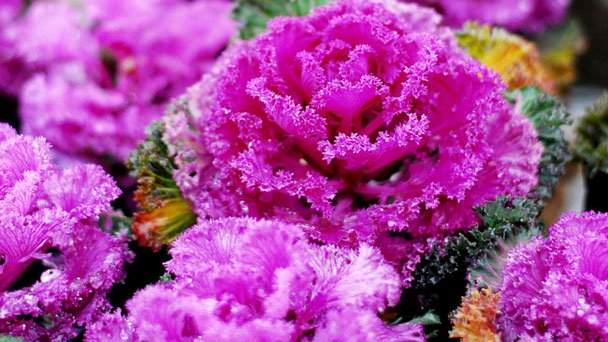
Flowering Kale (Brassica oleracea) is a type of cabbage that lacks the compact head associated with most cabbages. Flowering Kale plants are very ornamental thanks to their curly and textured leaves. Flowering Kale's leaves can be green, purple or more. These Flowering Kale plants are one of the undisputed Kings of the winter garden. Flowering Kale is hardy and silent, and can handle frost once ripe.
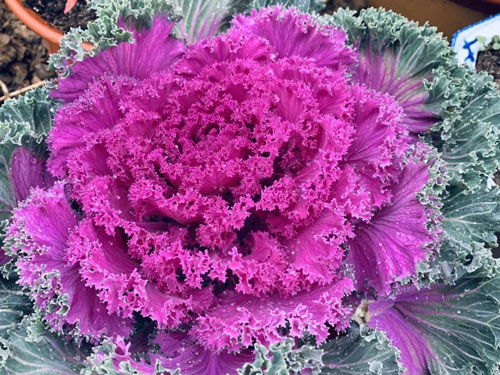
Sprinkle seeds about an inch apart over organically rich soil. Do not cover them. Germination takes 7 to 10 days.
Once seedlings have one set of true leaves, thin them to a distance of 18 to 24 inches apart.
For cuttings, find an extremely healthy side stem with multiple leaves, and cut it at the main stem of the plant. Trim off lower side leaves, leaving only the top leaf.
Once your side leaves are removed, examine what's left. If it's a large leaf, cut off the top half of the leaf, leaving only the bottom half attached to the stem. This reduces the size of the leaf that the stressed plant will need to care for.
Cut the base of the stem at a 45-degree angle just below one of the leaf nodes, and place into a pot of prepared, well-draining and damp potting soil. Mist the soil regularly to keep it moist, but not wet. It should develop roots within 3 weeks.
If you want to, you can dip the stem into rooting hormone before planting it, but this is purely an optional step. Some reports indicate that rooting is quicker and the plant healthier as a result.
You should be able to transplant your rooted cutting into the garden in about three months after hardening it off to the outside weather.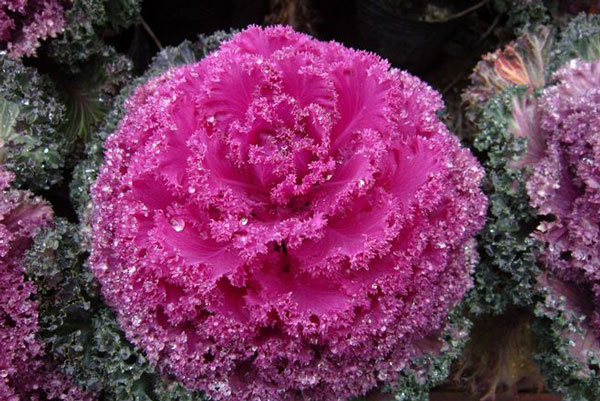
Temperature and Humidity
Though some Flowering Kale is cold-proof down to freezing, Flowering Kale's leaf mass, beta carotene, and lutein all increase as air temperature rises to 68 degrees F, and decrease as the air temperature increases further, according to a study.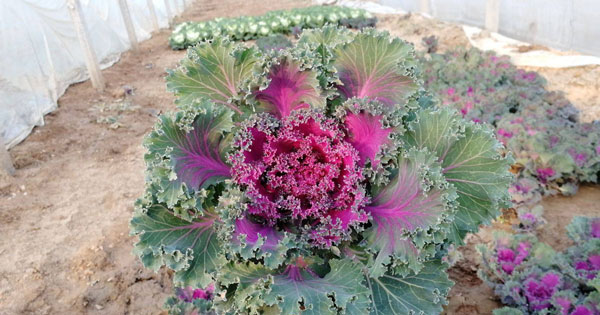
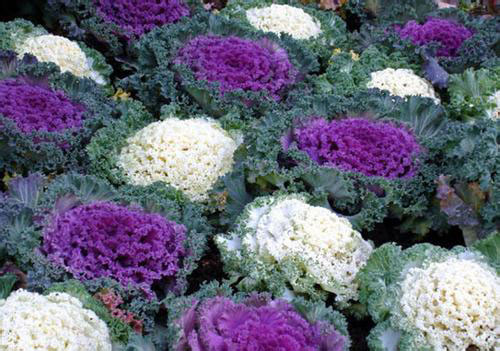
Here's a quick run of some Flowering Kale varieties you should consider.
Redbor. It has curly leaves, crisp texture, and mild flavor.
Lacinato. It boasts of very thick and hardy leaves that can even be harvested shortly after a snowfall.
Hanover Salad. Its pleasant taste makes it great for eating raw in salads. It grows fast and matures early.
Red Russian. Have smooth leaves with purple edges and veins. It has excellent resistance to slug and related pests in the garden.
Vates: This is a dwarf variety of Flowering Kale that that's bluish-green. It can withstand both cold and heat weather conditions.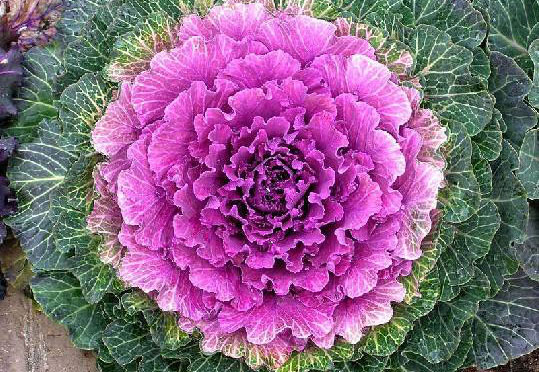
Harlequin bug, or Calico bug, is a shield-shaped stink bug that damages plants by sucking the sap out of stems. If brassica plants are not pulled immediately after harvest, these red and black bugs will have a field day with your Flowering Kale, collards, and broccoli. They are easy to spot but quickly drop off the plant when they sense a threat. Keep weeds away from the base of your Flowering Kale, so they don't have a hiding place. Knock them off the plant into a bucket of water with a bit of dish soap. The eggs of this bug look like little sushi rolls on the underside of the leaf and should be removed immediately. The University of Maryland Extension suggests floating row covers to exclude them, insecticidal soap, or using cleome as a trap crop.
Aphids are another sap-sucking pest that is partial to the Flowering Kale leaves, especially the crinkly ones. If it's feasible, blast them off with a forceful spray of water daily for several days in a row. Insecticidal soap is another option. A study found that intercropping herbs such as coriander, green onion, and parsley attracted plenty of aphid predators, such as spiders, causing aphids to disperse and therefore reducing the damage to plants.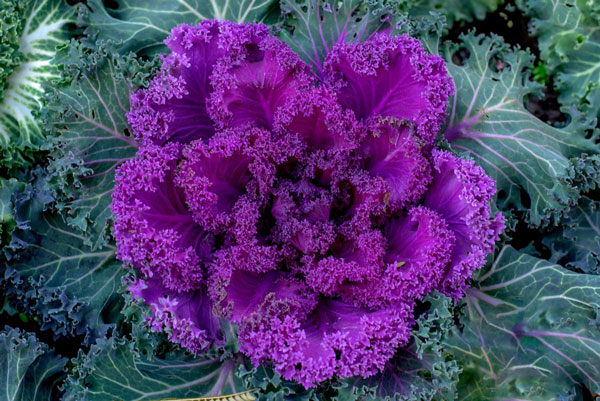
Storing and Preserving Flowering Kale. Leave Flowering Kale in the garden until you are ready to use it. Its flavor will be sweetened by frost. Flowering Kale will keep in the refrigerator for 1 to 2 weeks in a plastic bag. Flowering Kale can also be frozen, canned, or dried. (Find more fall plants here.)
A large ornamental Brassica oleracea var. acephala plant with vivid purple leaves growing in a container with deep red flowers amongst green foliage fading to soft focus in the background.
Here are some creative ways to incorporate them into the landscape:
Plant a border or drift in one color scheme, or alternate colors to create eye-catching patterns.
Interplant with other cool-weather vegetation, such as pansies, petunias, sedum, or snapdragon for colorful mixed beds, borders, or containers.
Pair tall varieties with asters and ornamental grass for vertical interest at the back of a garden bed. Be sure to stake as needed.
Make the most of tall, rose-like varieties by cutting them to arrange with other seasonal flowers. Remember to snip the stems, remove wilted leaves, and change the water daily, to avoid an odor reminiscent of cabbage.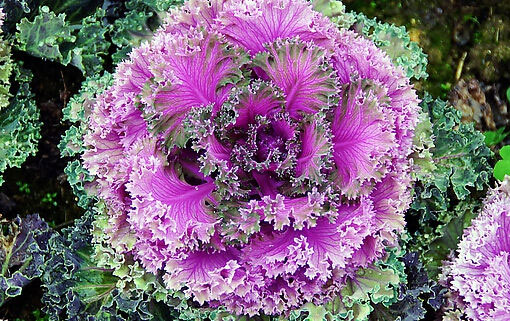
Dill and catnip are also excellent Flowering Kale companion plants because they attract pollinators that increase growth. Dill and catnip will attract beneficial insects that prey on Flowering Kale pests. Strongly scented herbs like lemongrass can deter pests like tobacco cutworms that will attack Flowering Kale. Mint, rosemary, and sage are also aromatic herbs that can repel pests when planted near Flowering Kale.
Flowers can also be planted as companion plants for Flowering Kale to provide numerous benefits, and are some of the best companion plants to have in your vegetable garden. Marigolds attract hoverflies and help them find the aphids they feed on, which will keep their populations under control. If cabbage loopers won't stop eating your Flowering Kale, grow nasturtium nearby. Nasturtium is a common “trap crop” that many pests find attractive, and its leaves and blooms can be sacrificed instead of your vegetable crops. Hyssop is an excellent pollinator attractor and can attract beneficial insects which will aid in Flowering Kale's growth. Strongly scented flowers can also deter pests, which makes them some of the best companion plants to grow in the garden.
Read Next:
Top 10 Most Beautiful Roses in the World
Top 10 Most Beautiful Flowers in the World
26 Best Autumn Flowers to Plant for Fall Color in Garden
Top 30 Fall Flowers to Plant - Beautiful Autumn Flowers
30 Fall Plants for a Beautiful Fall Garden
Flowering Kale PictureFlowering Kale InfoHow to Grow & Care for Flowering KaleHow to Grow Flowering KaleHow to Care for Flowering KaleKale BenefitsVarieties of Flowering KaleFlowering Kale Common Pests/DiseasesFlowering Kale HarvestingFlowering Kale Design TipsFlowering Kale Companion Plants
Flowering Kale Picture

Flowering Kale Info
| Botanical Name | Brassica oleracea |
| Common Name | Flowering Kale, ornamental Flowering Kale |
| Plant Type | Annual or biennial vegetable |
| Mature Size | 1 to 2 feet tall and wide |
| Sun Exposure | Full sun to part shade |
| Soil Type | Loamy, evenly moist, well-draining |
| Soil pH | Acidic (5.5 to 6.5) |
| Bloom Time | Early spring, Colorful Fall Foliage |
How to Grow & Care for Flowering Kale
How to Grow Flowering Kale
- With Seeds
Sprinkle seeds about an inch apart over organically rich soil. Do not cover them. Germination takes 7 to 10 days.
Once seedlings have one set of true leaves, thin them to a distance of 18 to 24 inches apart.
- With Cuttings
For cuttings, find an extremely healthy side stem with multiple leaves, and cut it at the main stem of the plant. Trim off lower side leaves, leaving only the top leaf.
Once your side leaves are removed, examine what's left. If it's a large leaf, cut off the top half of the leaf, leaving only the bottom half attached to the stem. This reduces the size of the leaf that the stressed plant will need to care for.
Cut the base of the stem at a 45-degree angle just below one of the leaf nodes, and place into a pot of prepared, well-draining and damp potting soil. Mist the soil regularly to keep it moist, but not wet. It should develop roots within 3 weeks.
If you want to, you can dip the stem into rooting hormone before planting it, but this is purely an optional step. Some reports indicate that rooting is quicker and the plant healthier as a result.
You should be able to transplant your rooted cutting into the garden in about three months after hardening it off to the outside weather.

How to Care for Flowering Kale
- Light
- Soil
- Water
Temperature and Humidity
Though some Flowering Kale is cold-proof down to freezing, Flowering Kale's leaf mass, beta carotene, and lutein all increase as air temperature rises to 68 degrees F, and decrease as the air temperature increases further, according to a study.
- Fertilizer

Kale Benefits
Kale is one of the best low-calorie foods, loaded with vitamin and minerals. It is high in Vitamin K and Manganese. Kale is also a source of the carotenoids – lutein and zeaxanthin. Boiling Kale decreases the level of glucosinolate compounds, whereas steaming, microwaving or stir-frying does not result in significant loss.
Varieties of Flowering Kale
There exist many types of Flowering Kale that are worth a try. Whereas the flat-leaf varieties of Flowering Kale establish faster, the curly-leaf varieties do better in cold weather.Here's a quick run of some Flowering Kale varieties you should consider.
Redbor. It has curly leaves, crisp texture, and mild flavor.
Lacinato. It boasts of very thick and hardy leaves that can even be harvested shortly after a snowfall.
Hanover Salad. Its pleasant taste makes it great for eating raw in salads. It grows fast and matures early.
Red Russian. Have smooth leaves with purple edges and veins. It has excellent resistance to slug and related pests in the garden.
Vates: This is a dwarf variety of Flowering Kale that that's bluish-green. It can withstand both cold and heat weather conditions.

Flowering Kale Common Pests/Diseases
There are a few critters to watch out for when growing Flowering Kale. Cabbage worms, for one, are the green “inch-worm” larva of those cute white moths that flutter around and appear harmless. Don't be fooled — they will devour whole leaves before you know it. After planting Flowering Kale, check daily for eggs and worms.Harlequin bug, or Calico bug, is a shield-shaped stink bug that damages plants by sucking the sap out of stems. If brassica plants are not pulled immediately after harvest, these red and black bugs will have a field day with your Flowering Kale, collards, and broccoli. They are easy to spot but quickly drop off the plant when they sense a threat. Keep weeds away from the base of your Flowering Kale, so they don't have a hiding place. Knock them off the plant into a bucket of water with a bit of dish soap. The eggs of this bug look like little sushi rolls on the underside of the leaf and should be removed immediately. The University of Maryland Extension suggests floating row covers to exclude them, insecticidal soap, or using cleome as a trap crop.
Aphids are another sap-sucking pest that is partial to the Flowering Kale leaves, especially the crinkly ones. If it's feasible, blast them off with a forceful spray of water daily for several days in a row. Insecticidal soap is another option. A study found that intercropping herbs such as coriander, green onion, and parsley attracted plenty of aphid predators, such as spiders, causing aphids to disperse and therefore reducing the damage to plants.

Flowering Kale Harvesting
Flowering Kale will be ready for harvest 55 days from transplanting, 70 to 80 days from seed. Cut individual leaves for use when the plant is 8 to 10 inches high; cut the outside leaves first. If you harvest the entire plant, cut 2 inches above the soil and the plant will sprout new leaves in 1 to 2 weeks. Harvest Flowering Kale before it gets old and tough.Storing and Preserving Flowering Kale. Leave Flowering Kale in the garden until you are ready to use it. Its flavor will be sweetened by frost. Flowering Kale will keep in the refrigerator for 1 to 2 weeks in a plastic bag. Flowering Kale can also be frozen, canned, or dried. (Find more fall plants here.)
Flowering Kale Design Tips
Summer gardens transition beautifully to fall and winter when you clear away plants that have finished blooming, and replace them with ornamental Flowering Kale rosettes.A large ornamental Brassica oleracea var. acephala plant with vivid purple leaves growing in a container with deep red flowers amongst green foliage fading to soft focus in the background.
Here are some creative ways to incorporate them into the landscape:
Plant a border or drift in one color scheme, or alternate colors to create eye-catching patterns.
Interplant with other cool-weather vegetation, such as pansies, petunias, sedum, or snapdragon for colorful mixed beds, borders, or containers.
Pair tall varieties with asters and ornamental grass for vertical interest at the back of a garden bed. Be sure to stake as needed.
Make the most of tall, rose-like varieties by cutting them to arrange with other seasonal flowers. Remember to snip the stems, remove wilted leaves, and change the water daily, to avoid an odor reminiscent of cabbage.

Flowering Kale Companion Plants
First, there are herbs that can improve the flavor of Flowering Kale and protect it from pests. Cilantro is a great Flowering Kale companion plant because it attracts beneficial insects like hoverflies. Hoverflies prey on pests like aphids, which will eat your Flowering Kale if left unchecked. If aphids are a problem on your Flowering Kale plants, you can also grow sweet alyssum, which is a flower that will grow well and attract hoverflies that will feed on aphids.Dill and catnip are also excellent Flowering Kale companion plants because they attract pollinators that increase growth. Dill and catnip will attract beneficial insects that prey on Flowering Kale pests. Strongly scented herbs like lemongrass can deter pests like tobacco cutworms that will attack Flowering Kale. Mint, rosemary, and sage are also aromatic herbs that can repel pests when planted near Flowering Kale.
Flowers can also be planted as companion plants for Flowering Kale to provide numerous benefits, and are some of the best companion plants to have in your vegetable garden. Marigolds attract hoverflies and help them find the aphids they feed on, which will keep their populations under control. If cabbage loopers won't stop eating your Flowering Kale, grow nasturtium nearby. Nasturtium is a common “trap crop” that many pests find attractive, and its leaves and blooms can be sacrificed instead of your vegetable crops. Hyssop is an excellent pollinator attractor and can attract beneficial insects which will aid in Flowering Kale's growth. Strongly scented flowers can also deter pests, which makes them some of the best companion plants to grow in the garden.
Read Next:
Top 10 Most Beautiful Roses in the World
Top 10 Most Beautiful Flowers in the World
26 Best Autumn Flowers to Plant for Fall Color in Garden
Top 30 Fall Flowers to Plant - Beautiful Autumn Flowers
30 Fall Plants for a Beautiful Fall Garden
Latest Updated
- Benefits of Bugleweed - 7 Science-backed Health Benefits
- Bugleweed Dangers & Side Effects - Is It Poisonous?
- How to Plant Evergreen Trees - What You Should Know
- When to Plant Evergreens - Grow Guide for Evergreen Trees
- 12 Wonderful Evergreen Shrubs for Your Garden
- 12 Popular Evergreen Plants with Pictures for Beginners
- When And How To Prune A Lilac Bush Like a Pro
- How to Grow & Care for Lilac Vine (Hardenbergia Violacea)
- Japanese Lilac Tree (Syringa Reticulata) Care & Propagation Guide
- Shumard Oak Pros and Cons - What to Know
Popular Articles
- Winter maintenance of Antirrhinum Majus
- How to Grow Terminalia Mantaly Tree
- How to Grow and Care for Crossostephium Chinense
- How to grow Antirrhinum Majus in spring
- Peristeria Elata (Dove Orchid) Profile: Info & Care Guide
- Underwatered Snake Plant (Sansevieria Trifasciata) - Signs And How To Fix
- How to Care for Brazilian Jasmine Plant (Mandevilla Sanderi)
- How to Grow & Care for Graptopetalum Purple Delight in Summer
- Rosa Chinensis (China Rose): Plant Growing & Care Tips
- How to Care for Baby Sun Rose (Aptenia Cordifolia)